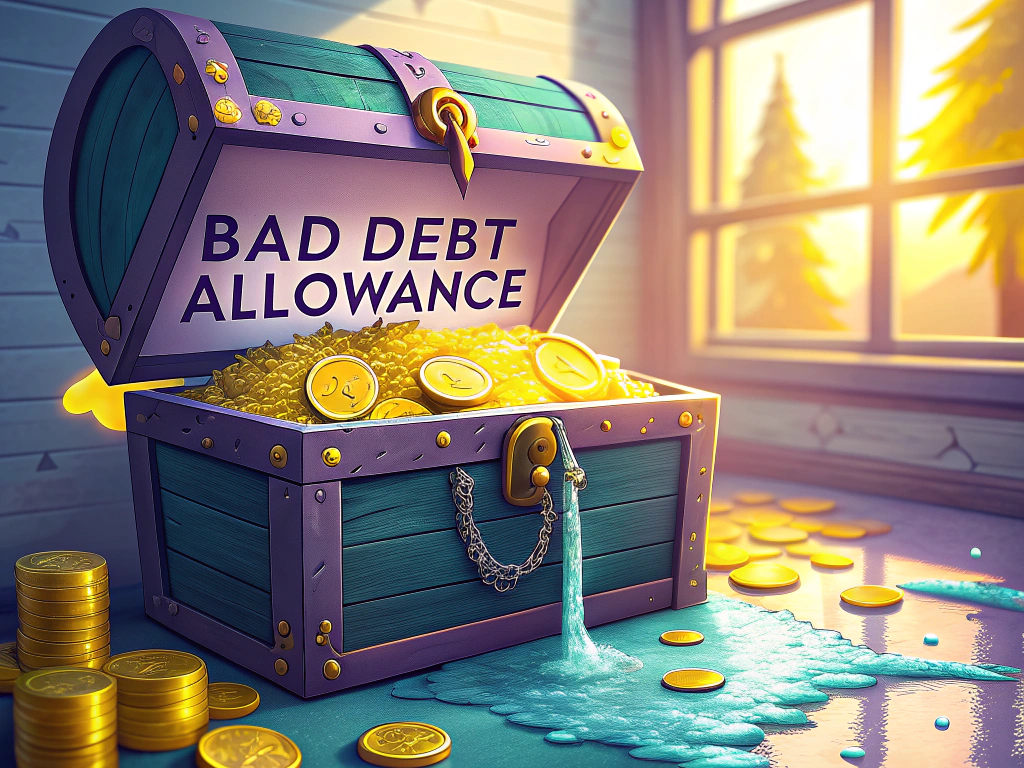Let’s cut to the chase: running a business isn’t all sunshine and rainbows. Sometimes, people owe you money and, well, they ghost you harder than your last Tinder match. That’s where bad debt comes into play—the cash you’re owed but probably won’t see, no matter how many times you hit refresh on your bank account.
In the accounting world, there are two main ways to deal with this financial hiccup: the direct write-off method and the allowance method. Both help you adjust your accounts receivable when it’s clear that collecting certain debts is about as likely as winning the lottery without buying a ticket. Today, we’ll dive deep into the adjusting entry for bad debt expense under both methods. Buckle up; it’s time to turn accounting woes into wows.
Related: How to Do Adjusting Entries with Examples
Bad Debt Expense Explained
Imagine this: You’ve just made a killer credit sale. You credit your revenue account and debit your accounts receivable. High-fives all around! But hold on—there’s a catch. Just because you’ve made a sale doesn’t guarantee that cash will actually grace your bank account. Shocking, right?
Accounting rules aren’t big fans of wishful thinking. Since there’s a chance you might not collect every dollar owed, you’re required to estimate the amount of uncollectible accounts and record it as a deduction against your net income. Think of it as a financial reality check. After all, revenue that doesn’t turn into cash is like a chocolate teapot—nice in theory, useless in practice.
This estimated uncollectible amount is known as bad debt expense. It’s the financial acknowledgment that some customers won’t pay up—maybe they went bankrupt, maybe they ran off to a tropical island. Who knows? The point is, you need to account for it. Most companies report bad debts as an allowance for doubtful accounts (also charmingly called a provision for credit losses) on the balance sheet.
On the income statement, bad debt expenses usually cozy up under sales and general administrative expenses. Recognizing bad debts also means making an offsetting reduction to accounts receivable on the balance sheet. But here’s the silver lining: if, by some miracle, a customer pays up after you’ve written off their debt, you can reverse the initial entry. It’s like finding a $20 bill in an old jacket—it doesn’t happen often, but when it does, it’s glorious.
See also: Accrued Revenue Adjusting Entry
Adjusting Entry for Bad Debt Expense
Bad debts are uncollectible amounts from customer accounts that throw a wrench into your accounts receivable. Recognizing these bad debts is necessary when you can’t reasonably expect to collect payment. As we mentioned, there are two methods to recognize bad debt: the direct write-off method and the allowance method. But what happens when circumstances change? That’s where adjusting entries for bad debt expense come into play.
Direct Write-Off Method and the Bad Debts Expense Adjusting Entry
First up, the direct write-off method. This is the accounting equivalent of ripping off a Band-Aid. When you decide an account is uncollectible—after dodged calls, ignored invoices, and perhaps some mild stalking—you write off the debt right then and there. You increase your bad debt expense and decrease the customer’s accounts receivable by the exact amount. No muss, no fuss.

In other words, you debit the bad debt expense account and credit the accounts receivable account. Let’s say a customer, Mr. Peter, has a $1,500 invoice that’s 91 days overdue. Your journal entry would look like this:
| Account | Debit | Credit |
|---|---|---|
| Bad Debt Expense | $1,500 | |
| Accounts Receivable | $1,500 |
Simple enough, right? But here’s the catch: The direct write-off method isn’t exactly best friends with Generally Accepted Accounting Principles (GAAP). Why? Because it violates the matching principle, which says expenses should be matched with the revenues they generate in the same accounting period. The unpredictability of when these bad debts occur makes the direct write-off method a bit of a rebel—and not in a cool way.
As a result, publicly traded companies steer clear of this method for official reporting. It’s like wearing pajamas to a business meeting—not exactly professional.
Adjusting Entry for Bad Debt Expense (Direct Write-Off Method)
But wait—what if Mr. Peter has a change of heart (or wins the lottery) and decides to pay up after you’ve written off his debt? Time for an adjusting entry! You’ll need to reverse the write-off entry by debiting accounts receivable and crediting bad debt expense. Then, record the payment by debiting cash and crediting accounts receivable.
Here’s how you’d reverse the write-off:
| Account | Debit | Credit |
|---|---|---|
| Accounts Receivable | $1,500 | |
| Bad Debt Expense | $1,500 |
And here’s how you’d record the payment:
| Account | Debit | Credit |
|---|---|---|
| Cash | $1,500 | |
| Accounts Receivable | $1,500 |
Allowance Method and the Adjusting Entry for Bad Debt Expense
Now let’s talk about the allowance method—the more sophisticated sibling in the bad debt family. This method is widely used because it plays nicely with the GAAP matching principle. Instead of waiting for a specific account to go bad, you estimate your bad debts upfront based on historical data or magical accounting formulas.

To set up an allowance for doubtful accounts, you debit bad debt expense and credit allowances for doubtful accounts (a contra-asset account). Suppose you estimate that $2,000 of your accounts receivable won’t be collectible this period. Your journal entry would look like this:
| Account | Debit | Credit |
|---|---|---|
| Bad Debt Expense | $2,000 | |
| Allowance for Doubtful Accounts | $2,000 |
When a specific account is identified as uncollectible, you write it off against the allowance account by debiting allowances for doubtful accounts and crediting accounts receivable. Let’s say Mrs. Mary has a $1,500 invoice that’s 121 days overdue. Here’s how you’d record the write-off:
| Account | Debit | Credit |
|---|---|---|
| Allowance for Doubtful Accounts | $1,500 | |
| Accounts Receivable | $1,500 |
Adjusting Entry for Bad Debt Expense (Allowance Method)
But what if Mrs. Mary suddenly decides to settle her debt after you’ve written it off? Yep, another adjusting entry is in order. You’ll reverse the write-off by debiting accounts receivable and crediting allowances for doubtful accounts. Then, record the payment by debiting cash and crediting accounts receivable.
The adjusting entry to reverse the write-off:
| Account | Debit | Credit |
|---|---|---|
| Accounts Receivable | $1,500 | |
| Allowance for Doubtful Accounts | $1,500 |
And to record the payment:
| Account | Debit | Credit |
|---|---|---|
| Cash | $1,500 | |
| Accounts Receivable | $1,500 |
Read also: When Are Adjusting Entries Recorded?
Example on Bad Debt Expense Adjusting Entry

Let’s bring this all home with another example. Suppose a customer buys a $25,000 car from you on August 1, 2022, expecting to pay it back in full by December 1, 2022. For simplicity’s sake, let’s say there’s no interest involved. (Lucky customer!).
The entry you initially make:
| Date | Account | Debit | Credit |
|---|---|---|---|
| Aug 1, 2022 | Accounts Receivable | $25,000 | |
| Inventory | $25,000 |
December 1 rolls around, and… crickets. The customer doesn’t pay up. Time to recognize this nonpayment as a bad debt. You’ll make the following journal entry:
| Date | Account | Debit | Credit |
|---|---|---|---|
| Dec 1, 2022 | Bad Debt Expense | $25,000 | |
| Accounts Receivable | $25,000 |
But in a surprising twist, the customer makes a full payment on May 1, 2023. Time to adjust! First, reverse the bad debt entry:
| Date | Account | Debit | Credit |
|---|---|---|---|
| May 1, 2023 | Accounts Receivable | $25,000 | |
| Bad Debt Expense | $25,000 |
Then, record the payment:
| Date | Account | Debit | Credit |
|---|---|---|---|
| May 1, 2023 | Cash | $25,000 | |
| Accounts Receivable | $25,000 |
And just like that, your accounts are back in order. Well done, financial wizard!
